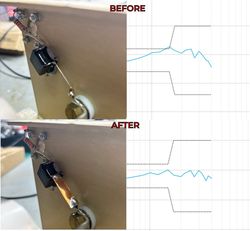Reducing Impedance: The Power of Flat Conductors
18 Sep 2024
What’s one of the first things you learn as an EMC Engineer?
Well, it’s not how to make a strong coffee so you can stay awake during those long RFS monitoring sessions! But it definitely helps.
Flat conductors exhibit a lower self inductance than round wire of the same length. This is why you see a lot of flat braid and flat ground plane connecting strips used in EMC testing.
I was asked to repair a number of Military/Aerospace LISN’s this week as they failed calibration. The one in the picture failed impedance calibration at around 150 MHz. At this frequency, the impedance contribution is mainly due to the coupling path to the RF port (loaded with 50 Ω). I needed to bring the impedance down and this is where a flat strip conductor comes into play.
The 22 mm long 0.5 mm diameter capacitor wire exhibits around 20 nH of self inductance, whereas the 22 mm long 6.5 mm flat strip of copper exhibits around 10 nH. This provides a lower impedance path to the RF port and has the overall effect of reducing the LISN impedance seen at the EUT port. The results on the right speak for themselves.

There are a great deal more factors at play that can affect the impedance, but this modification brings it down to almost normal values, so I’m happy with the result!
Get more from EMC Standards
EMC Standards is a world-leading resource for all things EMC and EMI related. Our website is packed full of both free and paid-for content, including:
- Online quiz
- Webinars
- Training quiz
- And much more!

Electromagnetic Engineering (EMgineering) is the basis for proven good design practices for signal integrity (SI), power integrity (PI), and the control of EMI emissions and immunity (EMC).
Our aim is to help people learn how to more quickly and cost-effectively design and manufacture electronic equipment (products, systems, installations, etc.) to meet functional (i.e. SI/PI) specifications and conform to EMC standards, directives and other requirements.
Such equipment should benefit from reduced warranty costs and financial risks, whilst improving uptime, competitiveness and profitability.
We also cover basic good electrical safety engineering; and the Risk Management of Electromagnetic Disturbances / EMI, whether for Functional Safety or other types of risk.
Join EMC standards TODAY!
